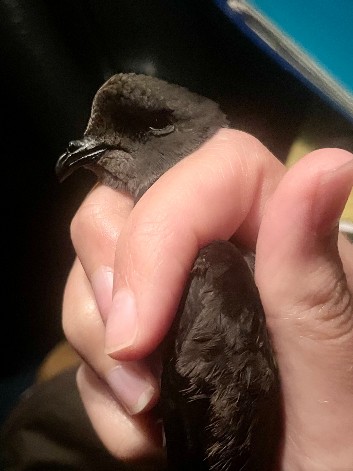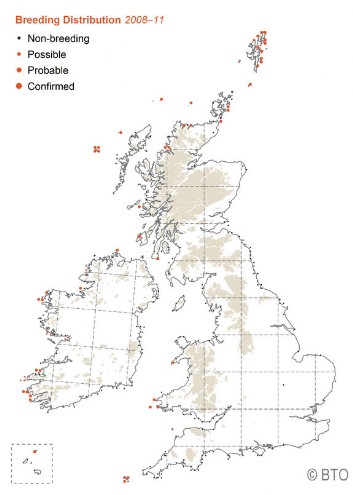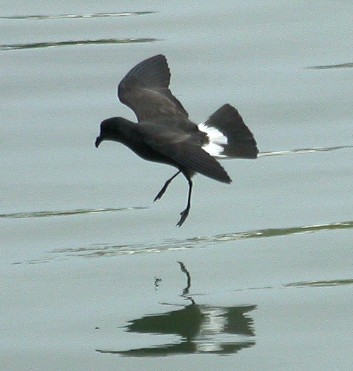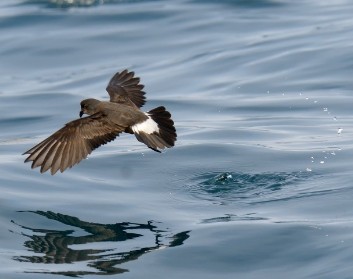Storm Petrel
Reports


In the very early hours of Saturday 17 June, a small group of licensed ringers set up their mist nests on a southern Arran shore. The conditions were right. It was dark, at high tide, relatively calm with a slight offshore breeze carrying the tape lure sound out to sea. They were attempting to find out if Storm Petrel were around Arran at this time of year. Their nearest breeding colonies are on the rat free islands of Sanda and Ailsa Craig. ( See breeding distribution map from British Trust for Ornithology)
The European Storm Petrel or just Storm Petrel Hydrobates pelagicus is a seabird in the family Hydrobatidae. Its systematic name comes from Ancient Greek and roughly translates as ‘to step on water on the open sea’. Storm Petrels are impressive birds, not much bigger than a House Sparrow but with the lifestyle of an albatross. True seabirds, they spend most of their time out at sea and only return to land to breed. Nesting in burrows or rocky crevices, they are vulnerable to predation from mammals like rats, so are usually only found on small, offshore islands where these animals are absent.
The small, square-tailed bird is entirely black except for a broad, white rump and a white band on the under wings, and it has a fluttering, bat-like flight. The large majority of the population breeds on islands off the coasts of Europe, with the greatest numbers in the Faroe Islands (400,000), United Kingdom (150,000), Ireland (100,000), and Iceland (100,000). This petrel is classified by the International Union for Conservation as being of least concern due to its high total numbers. Its presence in rough weather at sea has led to various mariners' superstitions.
This bird is strongly migratory, spending the Northern Hemisphere winter mainly off the coasts of South Africa and Namibia, with some birds stopping in the seas adjoining West Africa. This petrel is strictly oceanic outside the breeding season. It feeds on small fish, squid, and zooplankton, while pattering on the sea's surface, and can find oily edible items by smell. The food is converted in the bird's stomach to an oily orange liquid, which is regurgitated when the chick is fed. Although usually silent at sea, the Storm Petrel has a chattering call given by both members of a pair in their courtship flight, and a purring song given from the breeding chamber.
On that Saturday in June the ringers were delighted to confirm the presence of Storm Petrel when one bird was caught and ringed. The photograph of the bird in the hand shows the small bill with a distinctive ‘tube’ on top. It is a member of the group of seabirds known as tubenoses, which includes albatrosses, shearwaters and fulmar. The Storm Petrel's large nasal olfactory bulbs facilitate a keen sense of smell (unlike most birds), and the birds have a distinctive musty aroma which can help researchers locate breeding colonies.
The last record of Storm Petrel on Arran was ten years ago with two in Brodick Bay on 10 July 2013. An examination of the previous forty plus years of the Arran annual bird report has the first record as 1976 with three dazed by the Pladda light on 22 October. In the nineteen eighties there were records from seven years but only one or two records most years. In the nineteen nineties there were records from five years but again only one or two records most years. 1990 was an exception with nineteen records, fifteen in July, three in August and one in September. Most of these records were attributed to Tristan ap Rheinallt, the Arran bird recorder at that time. He had a passion for seawatching and spent many hours scanning the sea off the west coast of Arran. His records in 1990 included 26 off Dougarie on 13 July, 20 off Imachar on 17 July and 22 off Pirnmill on 18 July. In 1991 despite a similar intensity of observation there was only one sighting, 2 off Pirnmill on 1 July. In the first ten years of this century there were records from only two years and these were almost entirely single records from the Ardrossan/Brodick ferry in late summer. From 2010 until this year there was a single record in only three of these years, the last one being in 2013.
Storm Petrel are around. Look out for them in the late summer from headlands and while on the ferries. Flat calm seas or days with strong on-shore winds are best. They are a special bird.

